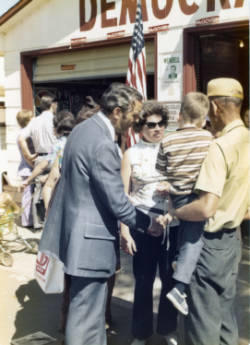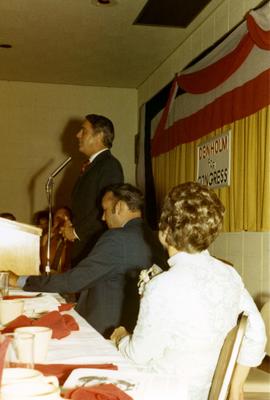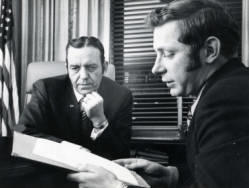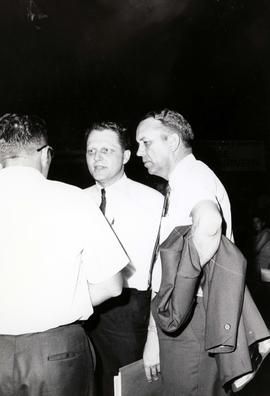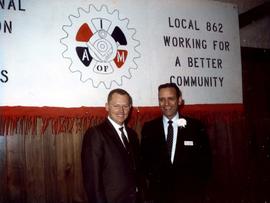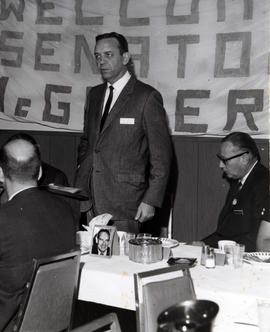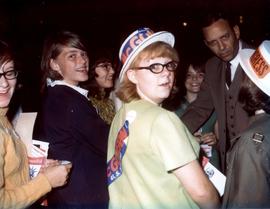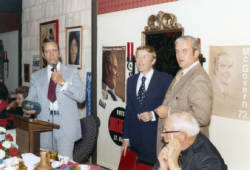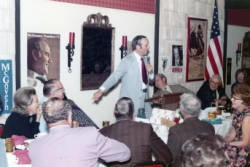Frank Denholm dancing with a woman a celebration in his honor for winning the Senate race in 1970 and celebrating his birthday Others in the room also dancing.
Frank Denholm and his wife Millie are riding in a convertible in the 1974 Hobo Day parade in Brookings, South Dakota
Frank Denholm and his wife Millie are riding in a convertible in a parade during his 1968 campaign for Congress
Frank Denholm campaigning at the Democrat Headquarters at the South Dakota State Fair in Huron, South Dakota
Frank Denholm is campaigning in front of the Democratic Headquarters at the South Dakota State Fair in Huron, South Dakota
Woman playing a guitar at a podium during a campaign event for Frank Denholm.
Man playing a guitar at a podium during a campaign event for Frank Denholm. Frank is seated to his left Millie Denholm is seated on the far left.
Man at podium speaking at a campaign event. Frank and Millie Denholm are seated to his left.
Frank Denholm talking with men surrounding him at a table during a campaign event. Millie Denholm is smiling.
Man speaking at a podium during a campaign event for Frank Denholm. Denholm is seated behind him. There is a banner hanging on the wall which says Congratulations Frank.
Frank Denholm working at his desk in his law office in Brookings, South Dakota
Frank Denholm going over a document with another man
Frank Denholm sitting at his office at desk
Frank Denholm at work in his office. There are two men standing behind him while he signs a document.
Frank Denholm working at a desk in his Washington, D.C. office.
Frank Denholm talking with a constituent at the South Dakota State Fair in Huron, South Dakota.
Frank Denholm talking with constituents at the South Dakota State Fair in Huron, South Dakota.
Frank Denholm talking with constituents by the Democratic headquarters at the South Dakota State Fair in Huron, South Dakota.
Frank Denholm talking with constituents by the Democratic headquarters at the South Dakota State Fair in Huron, South Dakota.
Frank Denholm signing his autograph for a constituent at the South Dakota State Fair in Huron, South Dakota.
Frank Denholm greeting constituents at the South Dakota State Fair in Huron, South Dakota
Frank Denholm and a man standing by the capital building in Pierre, South Dakota.
Frank Denholm at the South Dakota Democratic Party convention in Huron, South Dakota. He is holding his coat jacket under his arm and talking with Peder Ecker and another man.
Frank Denholm at the Democratic Party booth at the fari in Turner County, South Dakota. Mrs. Milton Jorgenson, Mrs. Don Jenter, Bill D. and Dick Koneig.
Frank Denholm standing at the Northwest ticket counter at the Sioux Falls Regional Airport.
Frank Denholm is going over a file while waiting for his flight at the Sioux Falls Regional Airport.
Frank Denholm in line to board a plane at the Sioux Falls Regional Airport.
Frank Denholm at an International Association of Machinists event. He is standing next to a man in front of a Local 862 sign.
Frank Denholm at an event for South Dakota Senator George McGovern
Frank Denholm standing at a podium at an event. A man with a donkey is to the right.
Frank Denholm seated at a long table with a group of people in a diner.
Frank Denholm with two constituents at an event.
Frank Denholm talking with constituents in a gymnasium.
Frank Denholm talking with other men at an event.
Frank Denholm standing behind a podium holding a microphone. His arm is around the woman standing next to him.
Frank Denholm speaking to a group of people at an event.
Frank Denholm speaking to a group of people at an event.
Frank Denholm talking with people at an event.
Frank Denholm (left) with group of people. A woman is holding a cake in the shape of a rabbit.
Frank Denholm shaking hands with a man at an event.
Frank Denholm shaking with a man at an event. A man is standing at the podium in the background.
Frank Denhoolm speaking at an event in a gymnasium.
Frank Denholm shaking the hand of a woman who is wearing glasses. A a younger woman is standing in the doorway.
Frank Denholm greeting a man at an event. Millie Denholm is standing to the left of him greeting people.
Frank Denholm mingling with guests at an event.
Frank Denholm at a podium speaking to an audience in an auditorium. A woman with a goat on a leash is standing in front of him.
Frank Denholm with people at an event.
Frank Denholm is in a classroom speaking to students.
Frank Denholm in a restaurant talking to a group of men.
Frank Denholm standing at the head of a table talking to people seated at the table.
Frank Denholm speaking to a group of people at an event.
Frank Denholm greeting a woman at an event.
Frank Denholm speaking to nuns at an event.
Frank Denholm greeting a man at an event.
Frank Denholm with Wayne Hauschild and another man at an event.
Frank Denholm standing at a podium speaking at an event. Wayne and Rosemary Hauschild are seate to the right of Denholm. Millie Denholm is seated to the left of Frank. She has a bouquet of roses on her lap.
Frank Denholm at an event. There is a group of people seated around him.
Frank Denholm standing next to a man at an event. Denholm has his eyes closed.
Frank Denholm standing at a podium at an event. A young boy in front of him and a man with a donkey is to the right. There are two other men standing to Denholm's left.
Frank Denholm at an event with a room full of people. They appear to be singing.
Frank Denholm greeting people at an event.
Frank Denholm at the 9th Annual Auctioneer's Convention. He is holding a gavel. Woman holding a cake that says 9th Annual Auctioneer's Convention.
Frank Denholm at the 9th Annual Auctioneer's Convention.
Frank Denholm at the 9th Annual Auctioneer's Convention. He is seated next to the speaker at the head table.
Frank Denholm speaking at the 9th Annual Auctioneer's Convention.
Frank Denholm at the 9th Annual Auctioneer's Convention. He is speaking at a podium holding a gavel.
Frank Denholm dancing with a woman at the 9th Annual Auctioneer's Convention.
Frank Denholm at the 9th Annual Auctioneer's Convention. He is seated at a long table eating with the group.
Frank Denholm at the 9th Annual Auctioneer's Convention. He is speaking at a podium holding a gavel.
Frank Denholm at the 9th Annual Auctioneer's Convention. He is seated at a long table eating with the group.
Frank Denholm demonstrating his auctioning skills at a sale.
Frank Denholm with a group of men at a South Dakota Democratic Party campaign rally. They are standing in front of a McGovern sign. One man is holding a hat with McGovern printed on it.
Frank Denholm is speaking to a Rotary Interational gathering. Richard Kneip is seated at the table to the left of Kneip.
People talking while seated at a long table in a restaurant. Frank Denholm is seated in the back by the wall.
Frank Denholm seated at a long table with a group of people in a restaurant.
Frank Denholm with supporters at a rally. They are wearing Denholm and McGovern hats.
Frank Denholm posing with American Indian dancers at a powwow
Frank Denholm posing with American Indian dancers at a powwow
Frank Denholm (seated) at a meeting in a room with a large window. He is listening to a man speak at the front of the room.
Frank Denholm is in an office with two men. They are seated and discussing an issue.
Frank Denholm speaking to a group in a room with a large window.
Frank Denholm at a luncheon meeting with a group of constituents.
Frank Denholm greeting constituents at a luncheon event.
Frank Denholm (right) with four other men standing on a dock at a lake.
Frank Denholm (left) with another man grilling steaks on a house boat on a lake.
Frank Denholm (right) with two other men relaxing on house boat on a lake.
Frank Denholm steering a house boat on a lake.
Frank Denholm is shaking hands with constituents at a Kiwanis Club meeting.
Frank Denholm speaking with constituents at a Kiwanis Club meeting
Frank Denholm talking with a woman at a Key Club event.
Frank Denholm at a Key Club event. He is standing with several other people.
Frank Denholm is holding a glass jar while standing at the podium at a Democratic Party campaign event. There are two men standing next to him.
Frank Denholm holds a microphone while a woman asks a question at a Democratic Party campaign event.
Frank Denholm is holding a glass jar while standing at the podium at a Democratic Party campaign event.
Frank Denholm is speaking at the podium at a Democratic Party campaign event.
Frank Denholm talks with the chef at a Christmas party.
Frank Denholm with two women at a Christmas party.
Frank and Millie Denholm with another couple at a Christman party.
Frank Denholm at a campaign event in Aberdeen, South Dakota. Two women are standing by a table with pies on it. There is a McGovern U.S. Senator hanging on the wall.
Frank Denholm at a campaign event in Aberdeen, South Dakota. He is holding a pie in his right hand that he is auctioning to the highest bidder. A woman is in the foreground.




